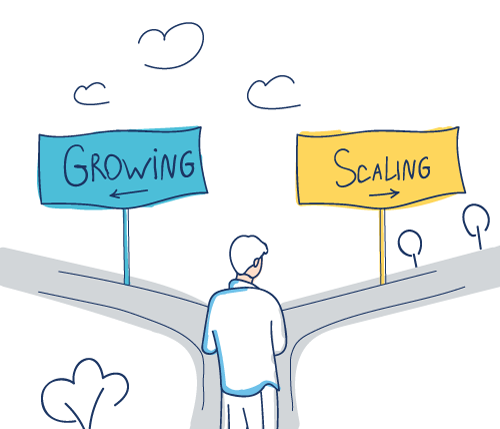Will Your Startup Ever Scale Up? Here's What You Need To Know

When will your startup scale up – if ever? And how?
According to the popular definition, about half of startups survive the first 5 years and only 1 in 200 become actual scaleups. Here’s what’s often misunderstood about the two ph(r)ases and what you can do as an ambitious founder or CEO to challenge the discouraging statistics..png?width=700&name=112%20(2).png)
The numbers presented above clearly show that major, exponential growth is not for everyone. And unfortunately, they don’t apply to Silicon Valley alone. They are global statistics on the number of companies that manage to take their business to the next level.
But don’t worry; they’re not stipulated in this article to make you lose your excitement or belief in your business model. Instead, they are meant to inspire you to take some rigorous and focused action if you are serious about skyrocketing your company’s growth.
Startup or scaleup? Common features and differences
Although often used to define a type of organization, the terms “startup” and “scaleup” actually refer to company phases or growth stages.
Startups and scaleups aim for the same amount of tremendous growth and impact but they are in different stages of their business life cycles.
When is your company a “startup”?
A startup can be defined as a new company with big growth plans and without geographic restrictions. It’s on a mission to find its repeatable scalable business model. They are still experimenting with things like segmentation, customer acquisition costs, and product features.
When people join your team at this phase, they decide to forgo stability for the promise of major growth and the excitement of making an immediate impact.
Where a startup is still in the early stages of getting their product in the right hands, securing funding, and getting their ducks in a row, a scale-up has already established their product in the market and is well on their way to accelerate their growth.
What is a scaleup?
Basically, you're a startup until you prove your business model. You’re a scaleup when you already have a proven model and you're scaling your revenue.
While the startup is still exploring its potential and discovering in what way it can best present its product or service to whom, the scaleup has already found that sweet spot.
In other words, the product-market fit has been perfected by scaleups. And when it comes to funding, scaleups can usually provide prospective investors with more validation than an MVP, a trustworthy team, and a great market opportunity alone.In its simplest definition, scale-ups are companies growing at 20% per year over a three-year period.
This means you can be a startup with a seemingly scalable business model and still never become a scaleup for lack of (customer) growth. Likewise, you can be a startup with revenue growth of over 20 percent YOY but still not have the scalable infrastructure, product or service that you are after.
When you envision the scaleup as a phase, you will also recognize scaling up can be a phase reached by any other (small) business or mid-market company as well.
But how do you move from one phase to the next? What are the main challenges in once you get there?
Main challenges in the startup phase
The main concerns of companies that are still in the startup phase are often related to funding, hiring the right people, partnering and winning trust in their respective industry. They are often battling with fierce competition and frequently encounter challenges related to financial management or cash flow.
The primary challenge for any startup is to create real products or services that people love. Not like. Love. Therefore, creating a strong feedback loop between customers and product developers will be an important focus for them, which can cause friction. Discerning between “nice-to-have” and “must-have” and learning how to prioritize is vital.
Sometimes, the “must-be-perfect” syndrome is present in startups and needs to be addressed properly. MVPs and rapid implementation are needed to push the company forward quickly and efficiently.
There’s never enough time when you’re starting out, so time management can be tough.
Because of constraints in time, resources, and cash flow, it’s not uncommon for startups to neglect marketing and sales. They may believe all the magic should or will happen through organic growth and word of mouth. But unfortunately, without a strategic, orchestrated effort to gain traction, sales and revenue are unlikely to increase.
And as in any business, hiccups and challenges may also arise due to lack of mentorship or poor management.
Main challenges in the scale-up phase
The moment you start scaling, two issues frequently arise. These are: (1) that most things were done manually up until now and (2) that everyone was doing everything.
Clear accountabilities for each team member in the startup phase are often lacking or insufficiently guarded. When you're scaling, you have to be – or quickly become – very good at building leadership systems and automating procedures.
In the scale-up phase, the complexity of decision making changes. There are more and more stakeholders involved and the level of risk the company can afford declines. It’s important to make calculated decisions in any stage, but at this point, it’s make or break.
Companies will have to ramp up their IT systems and their physical and organizational structures to handle the increasing complexities. Therefore, as the company continues to grow, challenges move more towards leadership, infrastructure, and marketing.
A scaleup needs to have the right systems in place in all three areas. Fast-growing companies may also experience struggles related to cash flow, as rapid growth comes with rapidly increasing costs too. They need a solid plan to finance their new hires, outsourced tasks, IT systems, and extra physical space.
It can become difficult (if not impossible) to maintain quality control and to complete projects on time without a proper, scalable infrastructure. Without enough focus on scaling up processes, the company will find itself throwing people at problems, firefighting, and frustrating both employees and customers due to the increasing amount of drama created by their lack of structure.
The leadership requirements will quickly change. If you want to 10x the business, you have to 10x the capabilities of the leadership and middle management ranks. Adding more management layers to the hierarchy without slowing down can be a difficult task to complete. Most companies do not do this well.
Finding and retaining the right people is one of the most pressing concerns of scaleups, apart from staying competitive and maintaining service levels. Because when it comes to people, it’s not just a matter of hiring a few extra FTEs: they must be the right ones in the right areas. After focusing mainly on the area of product development, organic growth, and perhaps marketing and sales in your startup phase, you’ll now also need talents in HR, administration, payroll, and support.
Like Jim Collins’ best-seller “Good to Great” read: you have to have the right people in the right seats on the bus. Collins explained with this metaphor, how executives who ignited transformations from good to great didn’t first figure out where to drive the bus and then get people to take it there: “No, they first got the right people on the bus – and the wrong people off the bus – and then figured out where to drive it.” Because even if you set the right direction, you’ll never become a great company with the wrong people.
And for those new hires, you need a proper onboarding system now. In the startup phase, new employees would easily get “up and running” because the roles and functions of each team member were still straightforward and quickly understood by “doing.”
For a new employee to understand the company’s mission, vision, cultural values, and processes equally fast in the scale-up phase, they often have to go through a quick crash course. And this course has to be created.
It's critical that the venture builds an effective marketing function separate from sales in this phase too. This way, the organization can stay focused on going after the right (and most profitable) customers. Marketing is also needed to attract enough of the right talent to keep up with the growth of the business.
Scaleups need to make sure their product increases in value, not in price, in order to stay competitive. You have to be smart in the way you do business, create a place where people love to work and implement the latest technologies to sustain your competitive edge.
Growth vs scaling up – a big difference
There’s a big difference between growing and scaling a company. And it’s not growth but exponential growth that startups are after and scaleups are manifesting. Meaning: if a startup or mid-market company wants to have a shot at making a lasting impact on its industry, they have to grow without accumulating a high amount of overhead.
To “grow” simply means to become larger or greater over a period of time but to “scale” means to represent in proportional dimensions or to increase (or reduce) in size according to a common scale.
More clients, an increasing amount of employees, and more or larger offices are all physical signs that a business is growing. But what benefit is there if it fails to impact the bottom line?
A common trap that many SMEs initially fall into is that they end up turning over more business, employing more people, and increasing their overheads but actually make the same or even less profit than when they started up.
When you’re scaling up, although you are adding customers and revenue exponentially, costs should only increase incrementally (if at all). Scaleups, therefore, aren’t experiencing steady, linear growth in all directions. Instead, they’re looking at those “hockey stick” curves in their growth metrics. This is in many cases achieved through systems that exponentially add revenue without the need to increase costs in equal proportion.
How to become a scaleup
In order to become a successful scaleup, the seed of potential growth won’t be enough to flourish – you’ll need to properly water the soil.
If you’re serious about moving your business to the next level, there are 7 fundamentals you need to take care of in the startup phase:
1. Commit to growth
The first key is the desire to really make a dent in your industry or even the entire society. As founder or CEO, you need to truly want your business to scale. Ambitious entrepreneurs need to create realistic growth targets and develop plans and concrete actions of how growth will be achieved.
2. Work on your leadership skills
It takes more than a founder to build a successful business and scaling up requires an expanded skill set. So if you’re serious about that, work on your own leadership and build a team with broad and complementary skills. It’s advisable to hire people accordingly, and to find mentors, read books, study the masters, and join peer groups to improve your capabilities.
3. Hire the right people
Your business can only become scalable when you have the right people on board. Hire only those that are necessary to the operation and outsource the rest. The type of hires you need are people that can do what a program can't, that are full of good ideas and that have more than one skill. When you hire people with a multifaceted skill set or skills that can be transferred to different tasks, you can stay flexible and agile in the face of rapid change.
 4. Collaborate with many
4. Collaborate with many
Collaboration is not only needed inside your company: your growth mindset needs to extend to partnerships with people and organizations outside the business. Entrepreneurs should build a network of partners, like service providers, sales partners, suppliers, and customers.
5. Focus on processes and automate
Standardized and repeatable processes free up time and resources. Make sure to implement them with proper delegation. Initially, this may require some investments in (IT) systems and training but it will pay for itself in the long term. Soon, you'll be able to access data faster, hire faster, market better, pay easier, and streamline operations for a truly scalable model.
6. Boost your marketing

No business can scale if no one knows about it. So focus on marketing, and scalability will follow. Find out which marketing channels bring you the biggest ROI. Test and implement because not every form of marketing is scalable. Direct marketing and word-of-mouth alone won’t do the trick in most cases. Especially when you’re just starting out. Use data to support your decisions and choose wisely.
7. Make yourself excusable
For your business to become truly scalable, it should be able to function without you. You can make yourself excusable by shifting responsibility off your shoulders and take deliberate absences. When your business is making money while you sleep, relax, or build something new, you feel liberated, your employees feel empowered, and the business is ready to grow.
The common mistakes that will keep your startup small forever
Of course, there are also a few mistakes startups and mid-market companies frequently make as they start scaling. These common mistakes can lead to unnecessary hiccups, stagnant growth, chaos, and perhaps even failure of the entire business.
Luckily, many are avoidable with the right preparation, planning, mentoring, and coaching or guidance.
1. Improper planning (or none at all)
Scaling up requires strategic planning but the experience, know-how, and resources to do so are often lacking. As a result, planning remains ad hoc and is often limited to statements about broad goals and perhaps the revenue growth that the company wants to accomplish. This is not enough to reach the next level. Without systematic planning and prioritization that the entire company can understand and is aware of, scaling up will be chaotic.
2. Lack of focus

Without a clear sense of direction, you will not hit your targets. Focus and commitment are key. It’s not only knowing what you should be doing but also knowing what you should not be doing at any point in time. For this, you need to have tools the right tools and systems in place so that everyone in your team is aware of their number 1 priority.
3. Mistaking leadership for management
Successful leaders are idea machines. They envision, inspire, make connections, and secure funding to create a sustainable business. Being a great leader is not the same as being a great manager. The two need different skills. In the initial startup phase, you may be able to handle all the functional roles, but it's a fatal mistake to believe you can continue to do so. Stay focused on your long-term vision as a business leader and leave managing and execution to people who are great at it.
4. Not hiring (or firing) on time

Someday, that big opportunity will come your way and you’ll need the resources and manpower to manage it. Don’t fall for the limiting belief that you cannot afford to hire. At the same time, be very picky about who you allow onto your workforce. Having the wrong people on your staff can do more harm than good, and it’s one of the most frequent mistakes entrepreneurs admit making and regret.
5. Postponing the next-round funding
Venture Capital firms that invest in later-stage funding are more risk-averse than your early-stage or pre-revenue investors. It usually takes much longer to attract them and seal the deal. Running out of money should be avoided at this point, so have your action plan in place early on and get ready to impress investors earlier than you may have intended.

If you’d rather take a different route than go after external funding, you can also work to create a customer-funded model. With a match-maker model for instance, you bring buyers and sellers together with no or limited investment up front, like Airbnb did. You can also choose to opt for a subscription model to secure a regular cash flow or a pay-in-advance model where you only build whatever your customer has already agreed to buy. Not all business ideas may offer these possibilities but it’s worth looking into.
6. Not being able to let go of the reins
 While many startup founders can initially succeed in growing their companies, not all of them can manage the hustle at all phases. There is great humility in recognizing your strengths and weaknesses as a business leader and seeking timely advice, coaching, and support. Although stepping down is never easy, it can open doors to the next amazing opportunity and can keep your business growing, even if it means you have to let go of the reins.
While many startup founders can initially succeed in growing their companies, not all of them can manage the hustle at all phases. There is great humility in recognizing your strengths and weaknesses as a business leader and seeking timely advice, coaching, and support. Although stepping down is never easy, it can open doors to the next amazing opportunity and can keep your business growing, even if it means you have to let go of the reins.
7. Not being agile
Although strategic action plans are important to achieve your vision, it can't be written in stone either. Sometimes things don't pan out as you envisioned and you have to change course quickly. Don’t pivot for the sake of pivoting but if you become stubborn or paralyzed, you will stall out. Success never comes failure-free. Other common mistakes are not having SMART goals in place, avoiding new technology or systems, ignoring the importance of marketing, not knowing the customer, overspending, and underspending,
Other common mistakes are not having SMART goals in place, avoiding new technology or systems, ignoring the importance of marketing, not knowing the customer, overspending, and underspending,
Reach out for help before, rather than after you experience rocky roads. There are plenty of coaches, mentors, and peer groups that have seen and experienced just about every type of failure; benefit from them to pave a more certain path.
Creating a smooth transition from startup to scaleup
Just like it’s important to get comfortable using a basic formula to solve easy algebra problems before you jump onto the complex ones, being comfortable with the current flow of the business is vital before you think about scaling.
According to StartupGenom's survey of 3200+ startups, 74% of failures can be explained by premature scaling. So make sure that you have a clear picture of who your customers/core users are, that you know which marketing channels bring you the biggest ROI, and that you have the resources to scale. Ask yourself:
- Do we have the right team in place?
- Are customers coming to us?
- Do we have revenue?
- Can we predict our profits?
- And are we able to control our costs?
If the answer to all the above is “yes”, you may be ready to start scaling. But how do you transition smoothly from a startup into a scale-up?
Scalability is a mindset that’s all about having the right systems and people in place to achieve that major growth you’re aiming for. Here are some tips to consider to scale without chaos and drama:
Get very clear on your focus – and make sure everyone knows
what that is
Focus and alignment are of vital importance in the scale-up phase. Make sure you have a clear sense of direction and that your entire team is on one page.
I wrote a bestselling book about how to scale up, called Scaling Up: How a Few Companies Make It...and Why the Rest Don't. I found that some of the biggest industry leaders of the world, like John D. Rockefeller, Steve Jobs, and Mark Zuckerberg, had a few habits, routines, and practices in common in their organizations and compiled them in a comprehensible method that helps business leaders reach the focus, clarity, and alignment that’s needed in this phase.
This method I am referring to here is called the Scaling Up methodology. With frameworks and tools like the Big Hairy Audacious Goal (BHAG), the One-Page-Strategic-Plan (OPSP) and the One-Page-Personal-Plan (OPPP), thousands of companies managed to scale up with success.
The BHAG, is a tool designed to clarify your long-term vision. What audacious goal do you want to reach 10-20 years from now?
With the OPSP you enable faster decision making and more team alignment. It’s a one-page document in which all strategic plans, targets, and goals are concisely clarified in a way that can be easily understood by everyone on your team..
But whatever tools and systems you choose to enhance focus and alignment in your company, make sure you have the right foundation to build on top of.
Be disciplined
Once you have a plan, follow your plan. Even after creating your strategic plans and your carefully thought-through goals and targets, it can be tempting to diversify and try new things. Be disciplined enough to stick to your original plan (your “what”) but agile enough to challenge your methods (your “how”).
Get a mentor
A mentor can help you think in a different way. Instead of just seeing through your own lenses, he or she will enable you to see through different lenses.
Leading a company that’s making 1 million in revenue, is not the same as leading one that’s making 5,10 million or more. Whenever you are doing something for the first time, remember that you don't know what you don't know.
Find yourself someone that has already gone through the process and can tell you exactly what it is that you don't know. Someone who can ask you the questions you need to answer in order to prepare yourself for the road ahead.
Get The Rockefeller Habits Checklist
Verne Harnish created the 10 Rockefeller Habits to counter the growth paradox and help organizations scale up quickly.
This simple set of habits has already helped over 70,000 companies scale up while reducing the time needed to run the business — many of which scaled to $10 million, $100 million, and a few, to a billion and beyond.
That’s the dream, isn’t it?
Get your free 10 Rockefeller Habits checklist here, so you can start implementing the proven frameworks and tools that reduce the complexity that comes with scaling up.




